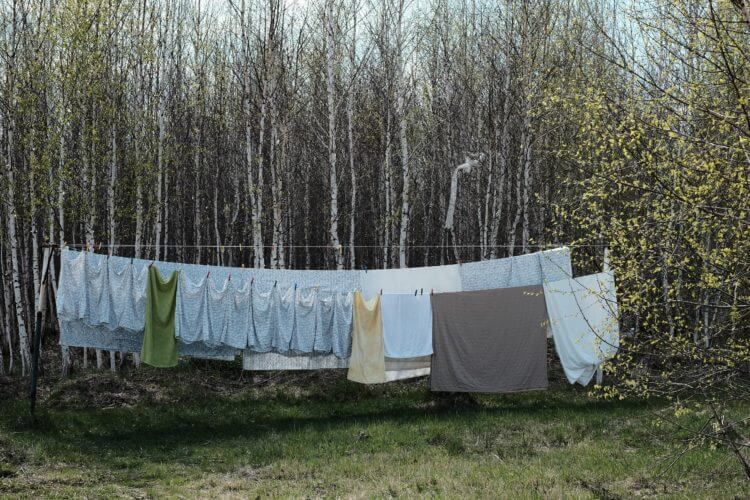Laundry and Mold
It is common knowledge that mold grows most frequently in rooms that serve as a basis for water use. The laundry room and dirty clothes hampers, in fact, are the ideal locations for mold to grow, as they generally provide mold spores daily access to a bountiful supply of decaying organic material (dirt, dust, sweat, food, urine, hair, body oils, etc.) to feed on and, in many cases, moisture.
With the potential of microscopic mold spores naturally teeming in the thousands (if not millions) inside and outside the home, it should come as no surprise that your chances—of acquiring mold growth in your laundry or dirty clothes hampers—are incredibly high. In fact, it is a constant battle, especially in more humid climates or in homes that have moisture issues.
Even if a home does not suffer from moisture issues, the simple daily tasks performed with your laundry could be inviting and maintaining mold growth. The purpose of this article is to reveal the top four mold-inviting mistakes you’re making with your laundry.
Before the Hamper
Do you pile your laundry on the floor in the corner or do you have a designated laundry hamper? Regardless of what method you choose, the important part is what state the dirty laundry was in when it was placed there and how long it took you before you put it through the wash.
Laundry is severely soiled with sweat:
So, they’re your work or gym clothes, or maybe it’s your bedding after a night of fevers. While they may not be drenched, they’re definitely going to feel damp to the touch. Wadding them up and throwing them in the pile/hamper/basket and then not washing them for over a week, is a pretty bad mold-inviting mistake. Mold loves bodily fluids. Get these washed within a week.
Laundry is soiled with food:
It could be a towel you used to mop up a chocolate milk spill, or maybe it’s your toddler’s shirt after lunch. This is worse than sweat. If you have a washer/dryer at home, then throw this in the wash tonight. If you don’t own a washer/dryer, then rinse out the food, squeeze out the water as best as you can, and hang up the item so it dries overnight before putting it in the pile/hamper/basket. Don’t just throw it in the hamper covered in food or sopping wet. That’s another terrible mold-inviting mistake. Mold loves most everything you eat. Get this washed in less than a week.
Laundry is wet:
This could be a washcloth or maybe it’s an accident your child had in his pants. Treat this the same as laundry soiled with food. (Hint: make the water as hot as your hands can stand, rinse out the item, and hang it up to dry before putting it in the hamper.) If it’s a heavy item like a comforter or bathroom rug, it needs to go into the wash the same day it becomes drenched because you, more-than-likely, will not be able to wring the moisture out and you may not even have a place to hang it adequately.
In the Hamper
As stated before, moist laundry or severely soiled laundry thrown into the hamper/pile/basket is a major mistake. This is because more and more dirty clothes are usually piled on top and the item never dries (even up until laundry day) or the washing or visit to the laundromat is delayed.
Life is unpredictable, you may not be able to get around to washing everything in that hamper. Or, perhaps, the item that is wet or soiled with food is a unique item and can’t be washed with other colors or types in the basket. That may mean you will have to delay its washing even further. Or perhaps you don’t even have a washer/dryer in your home. A lot of the time, laundromat patrons can only afford 1-2 loads each week, which will only further the delay of that wet or soiled item, which is a very friendly invitation for mold growth.
In addition to what moisture or soiled status the clothes had before entering the hamper, it is also important that whenever you empty the hamper for “laundry day,” you also take the time to clean the inside and outside of the hamper. Make sure to lift it and wipe underneath, as moisture sometimes accumulates beneath the plastic ones. If it’s a cloth hamper, it is usually machine-wash safe and you should probably take advantage of that.
During and After the Wash:
Be sure to use the right soap and the right temperature for each particular load—not only to maintain the color and appearance of the items, but also to fully clean them and remove any organic material (dirt, sweat, food, etc.).
Aside from leaving wet, dirty laundry in a pile and not washing it for over a week, one of the biggest laundry mistakes is done at the drying and immediately after the dryer.
- Ending the drying cycle before the load is completely dry. Whether it’s the crotch of your pants or the heels of your socks, it is a mistake to remove the items before they are dry.
- Folding items that aren’t completely dry and putting them away. This ensures that the moisture in that crotch or heel won’t dry up anytime soon. This is a another bad mold-invitation.
The Washer and Dryer
It’s important that you maintain cleanliness in the laundry room at all times. This means that you should:
- Wipe down the washer and dryer interiors and exteriors to keep them clear of dust, debris, soap spillage, or even dirty clothes filth transference.
- Check to be sure that the pipes, hosing, and plumbing are all attached correctly and tightly to avoid a water leak.
- Remove the lint hose from the back of the dryer each week or after a day-long laundry event and clean it out (Note: most house fires are caused by lint build-up that eventually catches fire from the heat produced by the dryer—these are the fires that go unnoticed and cause the most damage because laundry areas are usually designated to the basement).
- Remove the lint trap inside or on top of the dryer and clean out after every load.
- Keep the floors clean and dry, and move the washer and dryer to be sure that the space underneath is not harboring any mold-inviting debris, moisture, or grime.
If you or anyone else in the home is guilty of these mold-inviting mistakes, please practice proper mold-prevention immediately and stop supplying mold spores with moisture to thrive in and decaying organic material to feed on.
For more information regarding mold, mold prevention, and mold solutions, please check out the rest of MoldBlogger.com.
Amanda Mott is the mother and personal chef of two boys, the domestic technician of a three-bedroom town home, and occasionally, a freelance writer and editor. Feel free to follow her on Twitter @TheWifesLife



1 comment
Mold can manifest in homes that have a water leak or plumbing problem. Once mold,is introduced into an environment, it can quickly reproduce and spread in less than 72 hours.
Mold is a fungus that can grow on any organic surface (e.g. insulation, wood, carpet, foods and more). The conditions that are necessary for mold to thrive are moisture and oxygen.